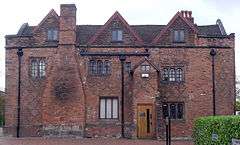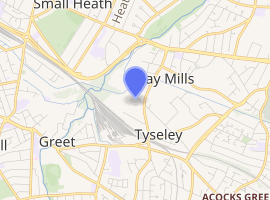Hay Hall, Birmingham
Hay Hall is a former 15th century moated hall located at Hay Mills, in Birmingham, West Midlands, England. In the 16th century it was refaced, and after a fire in 1810 it was rebuilt with a slightly modified layout with the back of the house now used as the front entrance.[1] Originally a sub manor of the Este family, the building form comprised a central open hall with cross-wings at either end. There are no traces of the original moat in the area, with the modern surroundings currently developed as factories and works, known as Hay Hall Business Park. It was listed Grade II in 1952.[2]
| Hay Hall | |
|---|---|
 | |

| |
| Former names | Haye Hall |
| General information | |
| Type | Brick |
| Address | Redfern Road, Hay Mills |
| Town or city | Birmingham |
| Country | England |
| Coordinates | 52.4580°N 1.8408°W |
| Completed | 1423 |
| Renovated | 1810, 1948 |
| Owner | Reynolds Tube Company Limited |
History
A moated house or manor was first founded at the site in about 1260 by the De La Haye family. Hay Hall passed on to the Este family in 1423, when the heiress Marian De La Haye married Thomas Este. They are commemorated in St. Edburgha's Church at Yardley by a wall sculpture depicting them. The Este family owned and occupied Hay Hall until the late seventeenth century, after which the property changed hands frequently. In 1917, the Patented Butted Tube Company purchased Hay Hall and a surrounding 13 acres of land. The estate was developed into new tube works and factories but Hay Hall was saved from demolition.
The last person to actually reside at Hay Hall was apparently a Mrs Shelley who was employed as a housekeeper by the then rebranded Tube Investments Company, and was known to be living in the Hall up until 1939. In 1948 the building was fully restored and is currently in use as private offices for the Reynolds Tube Company Limited.
Description
The central part of the house features an arch-braced collar-beam roof truss, typical of an open hall of the 14th or 15th century. Notable external features include exposed timber-framing on the south-eastern end wall, and a two-storied timbered porch containing a pointed arch. On the northeastern side of the building a solar wing was either originally encased in diaper-patterned brickwork, or the wing was a later addition in the 16th century. Its structure is formed in three bays divided by open roof trusses, and which were later enclosed in a dormered attic. It also features stone-mullioned windows. Inside the building Tudor wall painting and a fragment of stained glass have survived. After the fire in 1810 it was subsequently rebuilt and partly altered with the addition of a new five-gabled front to the southwestern side. The building was further refurbished and altered in 1948.[3]
References
- Historic England. "Hay Hall (331841)". PastScape. Retrieved 7 December 2011.
-
- Historic England. "Grade II (1076192)". National Heritage List for England. Retrieved 10 May 2012.
- Secular Architecture, A History of the County of Warwick: Volume 7: The City of Birmingham (1964), pp. 43-57. URL: http://www.british-history.ac.uk/report.aspx?compid=22961&strquery=hay+hall Date accessed: 8 December 2011.